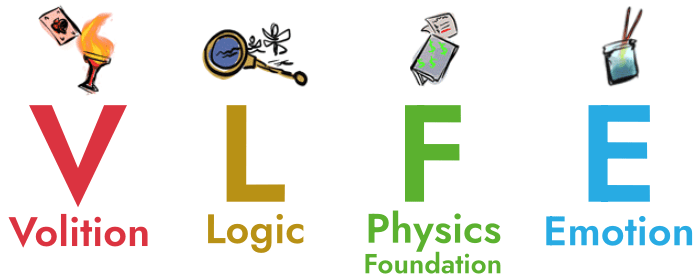
There are four main aspects of reality as described by Attitudinal Psyche. All objects, ideas, thoughts, feelings, reactions, actions and experiences can be categorized into one or more of the aspects. Please click on the aspect below to read more about each one.
Aspect Dichotomies
The four main aspects can be separated into three main dichotomies that give further meaning and clarity to how they are understood. These aspect dichotomies can be combined with attitudinal dichotomies to form an extremely refined understanding of each Attitudinal Psyche type. For example: VELF has self positive spiritual aspects, and self negative temporal aspects. VELF has aggressive expansive aspects, and passive emphatic aspects. All types can be broken down further into their dichotomies in this manner, which will offer the strongest understanding of how they manifest in attitude.
Expansive vs. Emphatic
Volition & Logic (Expansive)
The expansive dichotomy is the traditional “yang” energy that both volition and logic hold within them. Volition is all about raw determination, making decisions, and expanding one’s own personhood to include other ideas or designations. Likewise, the logic aspect is related to volition because it too reigns over an expansive view of how things relate to other things in a way that can be given a designated numerical or statistical value. Logic is calculation, which means determining or assessing the value and effect of a situation or course of action.
Physics & Emotion (Emphatic)
The emphatic dichotomy is the traditional “yin” energy that both physics and emotion hold within them. Physics is about raw responses to sensations, the body, objects that can affect the body, and how one places emphasis on their own relationship to their sensual perceptions. Emotions relates to our instinctive response or feeling that arises from a multitude of factors that involve people or things that affect us. It is a higher order than physics, but still retains the emphatic quality that we see in this dichotomy that differentiates it from volition and logic.
Visceral vs. Verbal
Volition & Physics (Visceral)
The visceral dichotomy is how volition and physics relate to one another through their intrinsic drive. This drive can be felt internally by the individual and seen externally by others. Both volition and physics are often seen through physical actions and instinct rather than words, however there will still be certain attitude positions where people do describe their relation to each aspect (the flexible and insecure positions). The visceral dichotomy is often seen as raw energy in the higher order for volition, or the more fundamental order for physics.
Logic & Emotion (Verbal)
The communicative dichotomy is how logic and emotion relate to one another by their need to compare, contrast, and differentiate themselves through verbal communication. Both aspects tend to be seen on the outside as highly language oriented. Although all individuals feel internal beliefs related to both aspects, the main point of both are to communicate something to others about what one knows or feels. The communicative dichotomy is usually seen as teaching oriented, whether that be instructing others on how things operate logically, or how to manage relationships.
Spiritual vs. Temporal
Volition & Emotion (Spiritual)
The spiritual dichotomy relates to the higher order of human attitudes or what one feels about themselves, their character, their identity, their relationships, religion, politics, or any other conceptual notion that aligns more with the complex and abstract realm rather than what we can point to with quicker objective realization. This dichotomy is not necessarily about anything religious, but rather the idea of the human spirit itself. Volition and emotion are both aspects that need a lot of supporting information beforehand to create ideas that pertain to their concepts and this is why they can come off more complex and difficult to define right away in comparison to the temporal aspects.
Logic & Physics (Temporal)
The temporal dichotomy relates to the more fundamental or lower order of human attitudes and how one deals with objects, specifics, details, particulars, data, information, sensations, and base needs that one might have. The temporal aspects are easier to quickly understand, because there is often real and available evidence to support their existence. This is an easy way to differentiate them from the spiritual aspects, as both logic and physics create the entire world around us at its most basic level. Everything we see, touch, taste, smell, and how those things operate with one another or are calculated in an objective way are what come together to form this temporal or real view of what comprises reality.
Blocks
A block is formed when two aspects come together in Attitudinal Psyche. Each block has a dominant (written first) and supporting (written second) aspect which can be inverted to reveal the block pair. There are a total of 12 blocks, and 6 block pairs which all reign over particular sub-aspects of reality. The blocks are placed into the functions to create the 6 unique dichotomies, gifts, and traps of the AP types.
